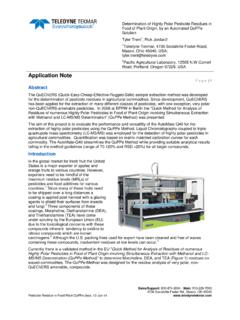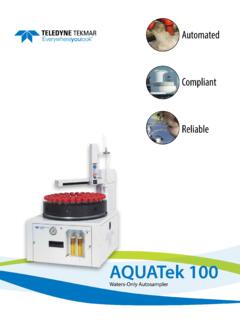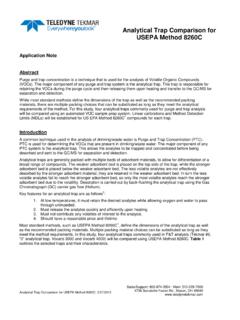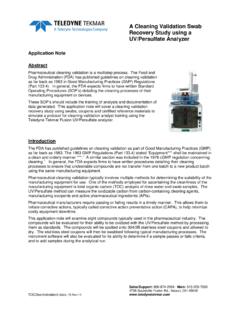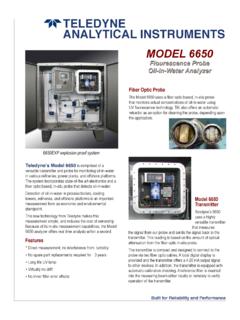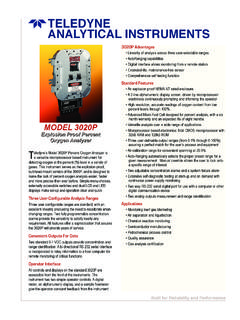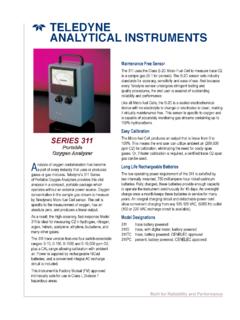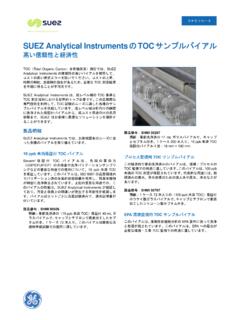Transcription of A Guide for Analyzing Low-Level Total Organic …
1 A Guide for Analyzing Low-Level Total Organic carbon using a UV/ Persulfate Analyzer Application Note By Stephen C. Lawson Guide to Low Level TOC UV/Persulfate Analysis; 11-Sep-09 Sales/Support: 800-874-2004 Main: 513-229-7000 4736 Socialville Foster Rd., Mason, OH 45040 Abstract Total Organic carbon (TOC) analysis is a fast and efficient analytical technique that can be easily implemented in pharmaceutical manufacturing for cleaning validation due to the all-inclusive nature of the test for carbon . It can be used to test for residues of previously manufactured products, cleaning detergents, solvents, by-products, and degradants. Although the current requirement set by the pharmacopeias for instrument performance is at 500 parts per billion (ppb), many pharmaceutical companies regularly test at one-tenth and even one-hundredth that requirement. This paper will discuss guidelines for performing Low-Level TOC analysis using a UV/ Persulfate analyzer.
2 Figure 1: Fusion TOC UV/Persulfate Analyzer Introduction Understanding the theory and application of instrument calibration is critical to successful operation. In this study, the UV/Persulfate analyzer is configured for Low-Level analysis using Static Pressure Concentration (SPC) technology (patent pending). SPC technology allows all of the carbon to be concentrated inside a Non Dispersive Infrared (NDIR) detector at a specified pressure setting. Once this setting has been reached and equilibrated, a single absorbance reading of the carbon is made, which correlates to the amount of carbon within the sample. Experimental - Instrument Conditions A reagent volume is the most suitable parameter setting for the generation of the calibration curve and subsequent analyses of calibration check standards. A part per million (ppm) working standard of Potassium Hydrogen Phthalate (KHP) is made by serial dilution from a 1000ppm KHP stock standard.
3 The working standard is used to generate the calibration curve by the autodilution feature of TekLinkTM software. Guide to Low Level TOC UV/Persulfate Analysis; 11-Sep-09 Sales/Support: 800-874-2004 Main: 513-229-7000 4736 Socialville Foster Rd., Mason, OH 45040 The method parameters used to generate the calibration curve are depicted in Table 1. The resulting calibration curve is in Figure 1. A 9mL sample volume and the use of the Low-Level NDIR filter are critical method parameters to perform analyses below Parameter Value Parameter Value Sample Volume Needle Rinse Volume Dilution 1:1 Vial Prime Volume Acid Volume IC Sample Prime Volume Reagent Volume IC Sparge Rinse Volume UV Reactor Prerinse Off Baseline Stabilize Time min UV Reactor Prerinse Volume Detector Pressure Flow 300mL/min Number Of UV Reactor Prerinses 1 Syringe Speed Waste 10 IC Sparge Time min Syringe Speed Acid 7 IC Sparge Time min Syringe Speed Reagent 7 Detector Sweep Flow 500mL/min Syringe Speed DI Water 7 Pre-Sparge Time min NDIR Pressurization 50 psig System Flow 350mL/min Syringe Speed Sample Dispense 7 Syringe Speed Sample Aspirate 4 Syringe Speed UV Dispense 7 Syringe Speed UV Aspirate 5 Syringe Speed IC Dispense 7 Syringe Speed IC Aspirate 5 NDIR Pressure Stabilize min Syringe Speed Sample Aspirate 4 Syringe Speed UV Dispense 7 Syringe Speed UV Aspirate 5 Syringe Speed IC Dispense 7 Table 1: These are the Fusion instrument method parameters used during Low-Level analysis.
4 By utilizing the Low-Level NDIR filter and a large sample volume [9mL] lower levels of detection are able to be achieved. Guide to Low Level TOC UV/Persulfate Analysis; 11-Sep-09 Sales/Support: 800-874-2004 Main: 513-229-7000 4736 Socialville Foster Rd., Mason, OH 45040 Figure 1: A calibration curve is generated by means of the TekLinkTM software autodilution feature. TekLinkTM software is able to generate a linear calibration curve with the calibration points 10, 25, 40, 50 and 100ppb from a working standard. Sample Analysis Table 2: Analyses of calibration check standards ranging from 20 100ppb. Each check standard is analyzed in triplicate. y = + = CountsConcentration (ppb)Calibration Curve 10 -100ppbPosition Analysis Type Concentration (ppm) Dilution Min / Max (% dev) Result (ppm) STD Dev. (ppm) RSD Percent Error B TOC 1:50 / (75%/125%) B TOC 1:40 / (75%/125%) B TOC 1:25 / (75%/125%) B TOC 1:20 / (75%/125%) B TOC 1:10 / (75%/125%) Guide to Low Level TOC UV/Persulfate Analysis; 11-Sep-09 Sales/Support: 800-874-2004 Main: 513-229-7000 4736 Socialville Foster Rd.
5 , Mason, OH 45040 Benefits/ Conclusion As mentioned earlier, the world pharmacopoeias have set the minimum standard for instrument qualification at However, the need for Low-Level analysis coincides with the increasing sensitivity of instruments and the demand for high-purity water. This demand for lower levels of analyses has shown up as people are increasingly moving from the parts per million to the parts per billion level for TOC sample analyses on bench-top analyzers. The use of SPC technology detection enhances the ability to analyze below the current standard USP 500ppb level. The calibration curve efficiency is evaluated through Analyzing Low-Level points as check standards using the automated dilution feature of the TekLinkTM software. As shown in Table 2, the Fusion performed very well on all calibration curves for linearity and precision. The standard deviations of 2ppb or less on all calibration check standards and low percent errors are another indication of excellent accuracy and precision of the Fusion.
6 The TOC Fusion UV/ Persulfate Analyzer has a combined instrument and autosampler platform, autodilution of standards and samples using TekLinkTM software, and SPC technology. All of these features combined with a sample injection volume of and the use of the Low-Level detector filter are important features for excellent analyses below 500ppb.
